Cabinet O: Shelf 2
Celadon Wares in Asia
Although Celadon is the term for a translucent crackle glaze applied to porcelain and stoneware, it has come to mean wares that are specifically greenish blue or gray in color, particularly those from China and Korea. The trademark greenish hues of celadon wares were achieved through the use of clays and glazes that contained small amounts of iron, which turns green in a reduction firing atmosphere. (When there is insufficient oxygen in the air in a kiln, oxygen molecules are pulled from the ceramics themselves; it is this change in chemical composition that changes the color of the ware.) The thickness of the glaze and type of clay determine the color after firing, and getting the “right” effect is extremely difficult. The thin watery glaze runs off high points in the design and pools in impressions, creating dazzling gradations in color, especially in incised and molded designs.
Jade was prized in East Asia, and the ability to imitate its color in porcelain was highly valued. In the Goryeo Period (918-1392) in Korea, a celadon ewer or teacup was more precious than gold or silver. The high estimation of celadon was not limited to Korea, but extended to discerning connoisseurs at the court of the Northern Song dynasty (960–1127) in China. Celadon was quite popular in Japan as well, where it was both imported and manufactured in a native version. Celadon is considered by many to have reached its height during the Goryeo period, and these wares continue to be prized by collectors today.
Created For
K-12 EducatorK-12 Student
Museum Visitor
UMMA Docent
UMMA Staff
University Faculty
University Student
Rate this Resource
AVG: 0 | Ratings: 0
& Author Notes
Creative Commons by-nc-saLast Updated
June 8, 2020 12:50 p.m.Report
Reporting Policy
![<p>This vessel was produced in a form typical of 13th century celadon bottles with the beautifully curved form and inlaid decorations on the entire surface. The body is divided into six segments, each of which is inlaid with chrysanthemum stems rst then stamped with owers using the inhwa (stamping) technique. Glaze was wiped away from the base and sand supports were used during ring. Glaze on the lower part of the bottle was poorly fused, yielding an opaque surface, however the overall quality of sintering is fine. The mouth has been repaired and restored. This piece is assumed to have been produced at a kiln at Yucheon-ri, Buan-gun, Jeollabuk-do.<br />
[<em>Korean Collection, University of Michigan Museum of Art</em> (2014) p.136]</p>
<p>This vessel was produced in a form typical of 13th century celadon bottles with the beautifully curved form and inlaid decorations on the entire surface. The body is divided into six segments, each of which is inlaid with chrysanthemum stems rst then stamped with owers using the inhwa (stamping) technique. Glaze was wiped away from the base and sand supports were used during ring. Glaze on the lower part of the bottle was poorly fused, yielding an opaque surface, however the overall quality of sintering is fine. The mouth has been repaired and restored. This piece is assumed to have been produced at a kiln at Yucheon-ri, Buan-gun, Jeollabuk-do.<br />
[<em>Korean Collection, University of Michigan Museum of Art</em> (2014) p.136]</p>](/media/W1siZiIsIjIwMjIvMDkvMjQvOTlvajVlZGNtbl9kZWZhdWx0LmpwZyJdLFsicCIsInRodW1iIiwiMjQweDIwMCJdXQ?sha=15576c14322f15fc)

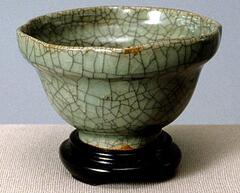
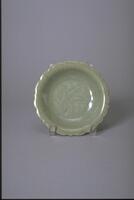
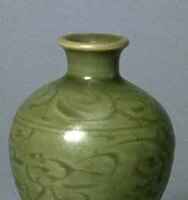
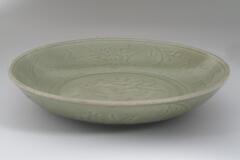
![<p>This piece represents the archetype of Goryeo celadon made in the 11th century with its shape and designs displaying the in uence of Chinese Yue ware. e glaze was fused well to form a subtle gloss, while the clay body has a ne and dense texture. Around the interior rim is an incised line and also engraved are parrots and clouds below the line. There are four refractory spur marks on the foot.<br />
[<em>Korean Collection, University of Michigan Museum of Art</em> (2014) p.91]</p>
Stoneware teabowl with celadon glaze. A pair of parrots is incised on he inside of the bowl, as well as a line that runs slightly below and parallel to the rim. <p>This piece represents the archetype of Goryeo celadon made in the 11th century with its shape and designs displaying the in uence of Chinese Yue ware. e glaze was fused well to form a subtle gloss, while the clay body has a ne and dense texture. Around the interior rim is an incised line and also engraved are parrots and clouds below the line. There are four refractory spur marks on the foot.<br />
[<em>Korean Collection, University of Michigan Museum of Art</em> (2014) p.91]</p>
Stoneware teabowl with celadon glaze. A pair of parrots is incised on he inside of the bowl, as well as a line that runs slightly below and parallel to the rim.](/media/W1siZiIsIjIwMjIvMDkvMjQvMnQyaGgxdHFoM19kZWZhdWx0LmpwZyJdLFsicCIsInRodW1iIiwiMjQweDIwMCJdXQ?sha=cb35f5778914b8e7)
![<p>The wide mouth of this cup gives it a form similar to that of a bowl. The foot has its glaze removed and has three refractory spur marks. Fine crackles are spread throughout the inner wall. The glaze is well fused, produing a shiny surface.<br />
[<em>Korean Collection, University of Michigan Museum of Art </em>(2014) p.121]<br />
</p>
<p>The wide mouth of this cup gives it a form similar to that of a bowl. The foot has its glaze removed and has three refractory spur marks. Fine crackles are spread throughout the inner wall. The glaze is well fused, produing a shiny surface.<br />
[<em>Korean Collection, University of Michigan Museum of Art </em>(2014) p.121]<br />
</p>](/media/W1siZiIsIjIwMjIvMDkvMjQvOTExZzNndjdwaF9kZWZhdWx0LmpwZyJdLFsicCIsInRodW1iIiwiMjQweDIwMCJdXQ?sha=4812735bad0e44fb)
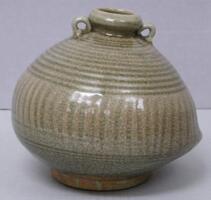
![The cup rest is decorated with a lotus medallion with two rows of petals and its edge and foot are also shaped like a flower.The surface is coated with a greenish blue glaze. The edge and foot of the cup stand are decorated with white inlaid chrysanthemum motifs.
<p>This is a cup stand used during ceremonies or rituals. The tray is white inlaid with lines and dots, and on each lobe of the tray is incised a pair of chrysanthemum florets inlaid with white and black slip. The pedestal for cup on the stand has the wall carved with inverted lotus petals with bland and white slip. The glaze is applied thickly and is partially oxidized, producing a green-brown hue.<br />
[<em>Korean Collection, University of Michigan Museum of Art </em>(2014) p. 127]</p>
The cup rest is decorated with a lotus medallion with two rows of petals and its edge and foot are also shaped like a flower.The surface is coated with a greenish blue glaze. The edge and foot of the cup stand are decorated with white inlaid chrysanthemum motifs.
<p>This is a cup stand used during ceremonies or rituals. The tray is white inlaid with lines and dots, and on each lobe of the tray is incised a pair of chrysanthemum florets inlaid with white and black slip. The pedestal for cup on the stand has the wall carved with inverted lotus petals with bland and white slip. The glaze is applied thickly and is partially oxidized, producing a green-brown hue.<br />
[<em>Korean Collection, University of Michigan Museum of Art </em>(2014) p. 127]</p>](/media/W1siZiIsIjIwMjIvMDUvMjUvM2V2c3pncTJwZ19kZWZhdWx0LmpwZyJdLFsicCIsInRodW1iIiwiMjQweDIwMCJdXQ?sha=7d92c3ec5609280a)
